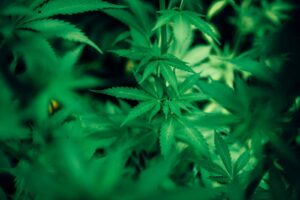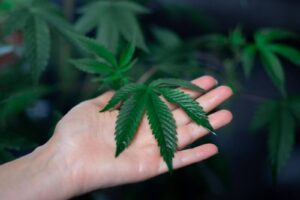Your weed got wet, and now you wonder if it is still good. Maybe you left it out in the rain, spilt a drink on it, or found condensation in a poorly sealed container. No matter how it happened, the important question is: can you save it? The good news is that wet cannabis is not necessarily ruined, but the drying process needs to be handled with care.
As a cannabis grower, ensuring your harvest dries properly is critical to preserving potency, flavor, and market value. Whether you’re dealing with high humidity or unexpected moisture, these tips will help you dry your cannabis efficiently without compromising quality.
Quick-drying methods exist, but they often sacrifice flavor and effectiveness. Let’s explore the best ways to dry weed quickly while keeping its quality intact.
Understanding the Importance of Proper Drying Wet Cannabis
When growing cannabis on a farm, several factors can lead to excessive moisture, making plants wet and vulnerable to problems. Heavy rainfall, morning dew, and high humidity levels create persistent moisture on leaves and buds, increasing the risk of mold and fungal diseases like Botrytis cinerea (bud rot) and powdery mildew. Without proper preventive measures, wet cannabis plants become more susceptible to disease, nutrient deficiencies, and lower-quality yields.
Why Slow Drying Matters
- Preserves Cannabinoids and Terpenes: The potency, aroma, and flavor of your final product depend on these compounds. Rushing the drying process can degrade them, lowering overall quality.
- Reduces Mold and Product Loss: Moisture trapped in buds can lead to mold, ruining your crop and costing you money. A gradual drying process minimizes this risk.
- Optimizes the Curing Process: Properly dried cannabis cures more efficiently, improving shelf life, terpene retention, and overall potency.
- Maintains Bud Structure and Bag Appeal: Slow drying prevents buds from becoming too brittle or overly dense, keeping them visually appealing and easier to trim.
- Improves Consistency Across Batches: A controlled, slow drying process ensures that every batch meets the same quality standards, helping you build a reliable reputation.
- Reduces Processing Headaches: Overly dry buds can be difficult to trim and package, while too much moisture can cause problems with storage and curing. Proper drying makes handling easier at every stage.
- Maximizes Weight Retention: While some moisture loss is necessary, drying too fast can lead to excessive shrinkage, reducing your final yield and profitability.
- Aligns with Compliance and Testing Standards: Many regions have strict regulations on moisture content. Drying cannabis correctly helps you stay compliant and avoid failed lab tests.
Warning: Quick drying can lead to harsh smoke and reduced potency.
The Risks of Rushing the Process
Speeding up the drying process can have several drawbacks:
- Loss of Potency: Overexposure to heat or air can break down cannabinoids, making the weed-less effective.
- Flavor Degradation: The terpenes responsible for taste and aroma can evaporate too quickly, leading to bland or off-putting flavors.
- Uneven Drying: Quick drying methods often dry the outer layer while leaving moisture trapped inside, increasing the risk of mold.
- Brittle or Overly Harsh Texture: Dried cannabis becomes too fragile, making it harder to trim and package while diminishing its market value.
- Risk of Chemical Changes: Rapid drying can alter the chemical composition of cannabinoids, impacting the overall effects and potency.
However, if you are in a hurry, there are ways to speed up drying while minimizing damage. Choosing the right method can help you balance efficiency and quality. With PlanaCan, you can track how different techniques impact your yield and keep all that data in one place. Reviewing these insights allows you to fine-tune your process, avoid repeating mistakes, and improve efficiency and profitability over time.
And that takes us to some of the quick-drying methods for cannabis.
Quick-Drying Methods For Wet Cannabis
Consider these effective methods if you need to dry wet weed fast without compromising too much on quality. Each technique has its own pros and cons, so choose wisely based on your available time and resources:
1. Drying Rooms: How to Set Up and Maintain a Climate-Controlled Drying Room
A properly designed drying room is essential for preserving cannabinoids, terpenes, and overall bud quality. Here’s how to set up an ideal space:
- Temperature Control: Maintain a consistent 60-70°F (15-21°C) to allow slow, even drying. Avoid high temperatures that degrade terpenes and cannabinoids.
- Humidity Levels: Keep humidity between 50-60% to prevent mold while ensuring a slow, even dry. Sudden humidity drops can cause buds to dry too fast on the outside while remaining wet inside.
- Lighting: Drying rooms should be completely dark to prevent cannabinoid degradation. Even small amounts of light can break down THC.
- Room Size & Insulation: Ensure that the space is properly sealed and insulated to prevent fluctuations in temperature and humidity. Large-scale growers should use HVAC systems for precise climate control.
- Cleaning & Maintenance: Regularly clean the drying area to prevent dust, bacteria, and mold spores from contaminating the buds.
Pro Tip: Use hygrometers to monitor humidity and temperature levels in real time.
2. Drying Racks: Using Mesh Racks for Even Airflow and Drying
Mesh drying racks are a great way to maximize space and improve airflow. They help prevent bud compression and reduce moisture retention.
- Choose Breathable Racks: Mesh racks allow 360-degree airflow, preventing mold and uneven drying.
- Spacing Matters: Place buds in single layers with space between them to prevent moisture buildup. Overcrowding can lead to damp pockets that encourage mold growth.
- Proper Placement: Store racks in a cool, dark, well-ventilated room. Avoid placing them near walls that restrict airflow.
- Rotation & Inspection: Check buds daily and rotate if needed to ensure consistent drying across all layers.
Pro Tip: Hang larger colas instead of placing them on racks to allow for a more natural drying process.
3. Industrial Dehumidifiers: Controlling Humidity Levels in Large Spaces
For commercial cannabis operations, humidity control is one of the most critical factors in maintaining quality.
- High-Capacity Dehumidifiers: Large-scale drying rooms require industrial-grade dehumidifiers to regulate humidity efficiently.
- Placement: Position dehumidifiers strategically to maintain even moisture removal across the space.
- Automatic Controls: Use humidistats to automate dehumidifiers and keep humidity levels consistent at 50-60%.
- Drainage & Maintenance: Ensure dehumidifiers have a proper drainage system to prevent standing water and bacterial growth.
Pro Tip: Monitor humidity at different points in the room—some areas may dry faster than others, leading to inconsistent results.
4. Air Circulation: Using Fans & Ventilation Systems for Consistent Drying
Proper air circulation prevents stale, humid air from accumulating, reducing the risk of mold and uneven drying.
- Use Oscillating Fans: Fans should gently move air throughout the room without directly blowing on the buds, which can dry them too quickly.
- Ventilation System: Install intake and exhaust vents to maintain a steady flow of fresh, filtered air.
- Avoid Stagnant Air: Dead air zones can lead to inconsistent drying. Position fans strategically to cover all areas.
- Filter Incoming Air: HEPA filters help reduce contaminants, dust, and mold spores in the drying room.
Pro Tip: A carbon filter can help remove odors from the drying room, useful for large-scale growers with odor concerns.
5. Hanging Drying Method
Hanging whole plants or branches upside down is one of the most common methods for preserving terpenes and cannabinoid content.
- Ideal for Larger Colas: Allows moisture to escape slowly, preventing over-drying.
- Requires a Stable Environment: Proper air circulation and humidity control are essential.
- Drying Time: It typically takes 7-14 days, depending on environmental conditions.
Pro Tip: Trim excess fan leaves before hanging to improve airflow and speed up drying.
So, should you choose microwave and oven methods to dry your wet cannabis? Let us find out.
Alternative Methods to Dry Wet Cannabis
If you’re dealing with wet cannabis and need a fast solution, you can use quick-drying methods to remove excess moisture. While these aren’t ideal for large batches, they can help you salvage small amounts in a pinch.
Microwave and Oven Methods: Should You Use Them?
- Microwave Drying: Spread your wet buds on a paper towel inside the microwave. Use short, low-power bursts—about 10–15 seconds at a time. Check and rotate the buds between bursts to dry them evenly. To prevent scorching, place a glass of water inside the microwave to help regulate the heat. Keep a close eye on them—microwaves work fast, but they can also dry out buds unevenly if you’re not careful.
- Oven Drying: Set your oven to the lowest possible temperature (around 150–170°F or 65–75°C). Spread the buds on a parchment-lined baking sheet and place them inside, with the oven door slightly open to let moisture escape. Stir or flip the buds every few minutes to dry them evenly. Depending on how wet your buds are, this process usually takes 20–40 minutes.
- Cannabis Dryers or Dehydrators: These appliances quickly remove moisture from buds, making them a popular choice for emergency drying. Set your dehydrator to the lowest possible temperature to prevent terpene loss, and check the buds frequently. Spreading the buds evenly on the trays helps ensure consistent drying. Depending on the moisture level, this process can take a few hours.
- Electric or Gas Heaters: If you have a dark, enclosed space on your farm, you can use a heater to warm the room and speed up drying. Keep temperatures below 90°F (32°C) to avoid cannabinoid and terpene degradation. Proper air circulation is key—use a small fan to keep air moving and prevent hot spots. Position the buds on drying racks or mesh screens for even airflow and faster results.
- Hygrometer for Monitoring: If you’re using a quick-drying method, a hygrometer is essential for monitoring humidity and preventing overdrying or mold. Alternatively, you can use PlanaCan to streamline your cultivation process. Customizable templates allow you to define each step, from planting to harvest. With just a few clicks, you can schedule tasks and maintain a smooth, consistent workflow.
How to Use These Methods Effectively
To get the best results from any drying method, follow these essential steps:
- Trim Excess Leaves: If your buds are still wet, trimming before drying (wet trimming) makes the process more efficient. Removing the fan and sugar leaves allows moisture to escape faster, reducing drying time.
- Break Down Large Buds: Instead of drying whole colas, separate them into smaller buds. This speeds up drying and prevents moisture from getting trapped inside dense flowers.
- Ensure Good Airflow: Whether using a dehydrator, heater, or another quick-drying method, place buds on mesh screens or perforated trays to allow air circulation. If using a heater in a drying room, position a fan nearby to keep air moving and avoid heat pockets.
- Check Regularly: Monitor the drying process closely to avoid overdrying or uneven moisture distribution. PlanaCan helps you track every stage by generating detailed reports on cultivation decisions and their impact on yield. With all data in one place, you can review past results, identify trends, and refine your monitoring process to achieve consistent, high-quality harvests.
- Store Properly: After drying, store your buds in airtight containers and burp them daily for at least two weeks. This allows moisture to distribute evenly, enhancing flavor, aroma, and potency.
- Maintain Optimal Conditions: Keep drying spaces at around 60-70°F (15-21°C) with humidity levels between 45-55% for the best outcome.
- Cure for Maximum Flavor: After drying, store the buds in sealed jars and burp them daily for at least two weeks to develop the best taste and aroma.
Here’s another best alternative, which is optional, to quick-dry your wet cannabis. Here’s in detail.
Live Resin Concentrates: A Quality Alternative
If dealing with wet cannabis is too time-consuming, turning it into live resin can be a practical and profitable alternative. Instead of drying and curing, you can freeze freshly harvested cannabis immediately after cutting and use specialized extraction methods to preserve its full chemical profile. By doing so, it retains more terpenes and cannabinoids compared to traditionally dried cannabis, resulting in a product that delivers a richer flavor and enhanced potency. Here are some of the benefits of live resin concentrates:
- Preserves Crop Quality: Freezing wet cannabis prevents degradation, allowing you to maintain premium-grade products even if your harvest is unexpectedly exposed to moisture.
- Increased Potency: Preserves higher levels of cannabinoids, making it a more effective and powerful option.
- Maximizes Terpene Retention: Unlike traditional drying, which can strip away terpenes, live resin captures the plant’s full aroma and flavor profile, increasing its market value.
- Longer Shelf Life: Properly stored live resin remains fresh longer than dried cannabis, giving cultivators more flexibility in distribution.
- Diversifies Product Offerings: Live resin is a premium product that allows you to expand your business into the concentrate market, increasing revenue opportunities.
How Growers Can Process Live Resin
- Flash-Freezing: Immediately after harvest, freeze the cannabis at -40°F (-40°C) or lower to lock in cannabinoids and terpenes.
- Extraction: Use a closed-loop extraction system with butane hash oil (BHO) or other hydrocarbon solvents to safely extract live resin from frozen material. This method prevents solvent loss, enhances yield, and ensures compliance with industry safety standards.
- Storage: Keep the final product in airtight, UV-protected containers at cool temperatures to prevent degradation and maintain potency.
While creating live resin requires specialized equipment and knowledge, it is a premium alternative for those looking to maximize the quality of their cannabis experience.
Conclusion
For commercial cannabis growers, patience is key when drying your harvest. Traditional slow-drying methods provide the best results by preserving potency, flavor, and overall quality, which are essential for premium products. While fast-drying techniques exist, they often reduce terpene retention and cannabinoid integrity. If efficiency is a priority, choose a drying method that balances speed with quality to maintain a marketable product.
If you are looking to optimize your cultivation process, PlanaCan provides innovative solutions and features to simplify task management. You can define and automate cultivation processes using customizable templates, making everything from planting to harvest smooth and efficient.
PlanaCan also provides a clear visual timeline, helping you manage daily tasks and plan for months ahead. With easy adjustments and centralized information, you won’t overlook any task, ensuring maximum yield efficiency.
Schedule a free call today to see how PlanaCan can help you elevate your cannabis cultivation process.




